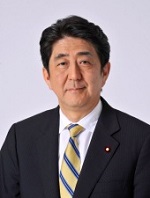 |
| Japan Prime Minister Shinzo Abe |
Japan has ramped up spending on healthcare as part of a broader effort by the government to spur innovation and revive economic fortunes for drug and device makers while at the same time trying to tame costs for reimbursement and hiking sales taxes.
Now commentary in the Japan Times and from the local press suggests something has to give.
Japan's population will see in one in three people reaching age 65 or older in 2035, the Japan Times noted in a recent story.
That points to why the Council on Economic and Fiscal Policy, headed by Prime Minister Shinzo Abe, is weighing an overhaul of the social security system with a domestic debt to GDP ratio of 227% and the central bank spending ¥80 trillion annually to buy government bonds.
The dire fiscal situation led Japan's cabinet to tell Health Minister Yasuhisa Shiozaki in May that even setting a goal of an 80% prescription rate for generics by fiscal year 2020 to save about $10.5 billion was not enough.
But Tomohiro Tada, a gastroenterologist and proctologist at Musashi-Urawa Medical Center in Saitama Prefecture, exemplifies how difficult saving money on reimbursement through generic drugs will be for Japan.
"The government should stop saying generics are the equivalent of branded drugs," Tada told the Japan Times. "It's like saying Matsuzaka beef is the same as ordinary beef sold for ¥100 per 100 grams."
At the same time, members of the government's Council on Economic and Fiscal Policy reiterated calls in the local press to revise NHI drug prices annually instead of once every two years to curb Japan's social security spending.
This has alarmed Japan's big drug companies who claim it will quash innovation and that Japan, the world's second most valuable country market, would not be a player on the global drug scene as a result.
In addition, some drugmakers want higher prices based on cost-effectiveness assessments by the Central Social Insurance Medical Council (Chuikyo).
But that process, if followed for all innovative drugs, could have seen compounds like Gilead's ($GILD) Sovaldi (sofosbuvir) fetch a higher NHI price because it is a cure in most cases, rather than treatment for a chronic condition, patient advocacy groups warn.
Japan's health ministry signed off on including the drug among those subsidized by the national health plan and set its price at about $515 per daily dose.
The regimen requires 12 weeks of doses, so the government would have to shell out nearly $43,000 per patient after the patient copay of about $335 for the full regimen.
But the price of about ¥61,800 yen per tablet was much lower than a developed country overseas average of ¥92,000 yen per tablet, local press noted.
Chuikyo and the Ministry of Health, Labor and Welfare (MHLW) are reportedly looking into 5 drugs and three medical devices that may rate higher prices under an assessment system linked to innovation, according to an industry source.
The outcome of the study could even set the tone for innovation among Japanese companies and research institutes looking to develop candidates from stem cells to vaccines and high-tech diagnostic equipment that are seen as a source of national economic renewal aspirations.
So capping the price genie in Japan through generics looks increasingly like a long shot.
- here's a story from the Japan Times and from the MHLW website